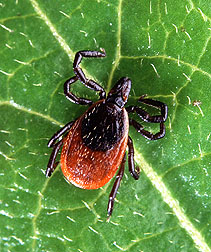|
|
|
|
ARS Leads New Lyme Disease Control Efforts in Howard County, Md.
By Kim Kaplan
January 31, 2017
BELTSVILLE, MD, Jan. 31, 2017—The U.S. Department of Agriculture’s Agricultural Research Service (ARS) is leading efforts to combat Lyme disease in the Old Line State. Agency scientists are working with the Howard County (Md.) Department of Recreation & Parks (DRP), and the University of Maryland to study new ways to control deer ticks. The size of a sesame seed, deer ticks—via the backs of mice and white-tailed deer—spread the bacteria that cause Lyme disease.
Beginning in early February, efforts to measure deer tick movement will begin with the capture of white-tailed deer in seven different Howard County locations: Blandair Park, Cedar Lane Park, Centennial Park, David Force Natural Resource Area, Middle Patuxent Environmental Area, Rockburn Park, and Savage Park. After being fitted with a GPS collar, scientists will track the released deer’s movement between residential areas and parklands. Understanding deer movement will key further efforts to control tick populations.
“Our goal is to identify an effective way to reduce tick populations and the associated spread of Lyme disease and other tick-borne illnesses they cause in suburban areas,” said entomologist and project lead Andrew Li with the ARS Invasive Insect Biocontrol & Behavior Laboratory in Beltsville, Md.
Ultimately, the study will test the effectiveness of single and combined control measures on deer tick numbers and tick-borne diseases in locations throughout Howard County. Those control methods will include rodent bait boxes, ARS-patented “4-poster” deer treatment feeders, and bioinsecticide spray. The study is part of a larger, five-year Area-Wide Integrated Tick Management Project under way at ARS.
More than 300,000 people contract Lyme disease through tick bites annually in the United States, primarily in the northeast.
The Agricultural Research Service is the U.S. Department of Agriculture's chief scientific in-house research agency. ARS focuses on solutions to agricultural problems affecting Americans every day.

